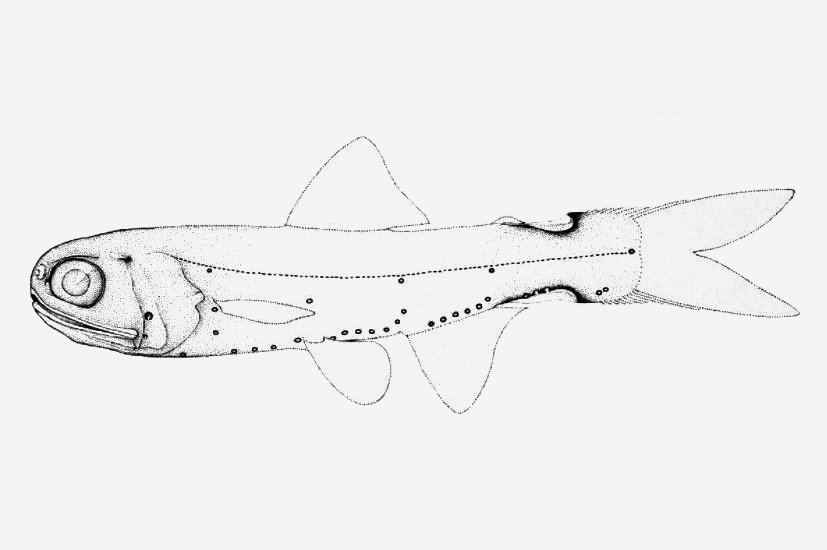Notal Lanternfish, Lampadena notialis Nafpaktitis & Paxton 1968

Illustration of the holotype of the Notal Lanternfish, Lampadena notialis, LACM 11321-1, 66.3 mm SL, from the South Pacific Ocean, 42°00'-08'S, 160°11'-05'E, depth 0-800 m LACM 11321-1.. Source: Fig. 5, in Nafpaktitis & Paxton (1968) Contributions in Science (Los Angeles) 138:1-29 / Biodiversity Heritage Library. License: CC BY Attribution
Summary:
A relatiely large, robust lanternfish with large very well-developed whitish supracaudal and infracaudal glands outlined in black, and a blackish iris with gold mottling.
The infracaudal gland is relatively long (distance between rear base of anal fin and anterior base of infracaudal gland about one quarter gland length), the supracaudal gland is shorter than the infracaudal gland in both sexes, and the dorsal-fin base is equal to or longer than anal-fin base.
The infracaudal gland is relatively long (distance between rear base of anal fin and anterior base of infracaudal gland about one quarter gland length), the supracaudal gland is shorter than the infracaudal gland in both sexes, and the dorsal-fin base is equal to or longer than anal-fin base.
Cite this page as:
Bray, D.J. 2021, Lampadena notialis in Fishes of Australia, accessed 06 Jul 2025, https://fishesofaustralia.net.au/home/species/4031
Notal Lanternfish, Lampadena notialis Nafpaktitis & Paxton 1968
More Info
|
Distribution |
Off south-western Western Australia, and off Newcastle, New South Wales, to south of Tasmania; also the Lord Howe Plateau, and the Norfolk Island region in the Tasman Sea. Elsewhere the species is widespread in the Southern Hemisphere, in the southern convergence zone from 30°- 47°S in the Atlantic, Indian and Pacific Oceans to New Zealand. |
|
Features |
Dorsal fin 14; Anal fin 14; Pectoral fin 14; Pelvic fin 8; Gill rakers 22-26; PO 5; VO 5(6); AOa 6; AOp 3; Prc 2+1; Lateral line scales 38-39; Vertebrae 37-38. A relatively large myctophid fish; body rather robust, gently tapering from vertical through base of pectoral fin to a deep caudal peduncle; dorsal and ventral contours anterior to pectoral fin evenly curved; snout rather high and bluntly rounded; mouth large, slightly subterminal, its cleft moderately oblique; eye large, its diameter 2.8 to 3.0 in length of head; posterior opercular margin produced into two rounded lobes separated by a triangular indentation located at about level of PV0 2 ; pterotic spine directed posterolaterally in juvenile and posteroventrally in adult. Origin of dorsal fin distinctly in advance of vertical through base of outermost ray of pelvic fin; origin of anal fin behind vertical through end of base of dorsal fin; base of adipose fin about over end of base of anal fin; pectoral-fin rays extending slightly beyond pelvic-fin base; pelvic-fin rays reaching first or second anal-fin ray; dorsal fin base equal to or longer than anal fin base. Infracaudal gland relatively long, distance between posterior end of base of anal fin and anterior margin of infracaudal gland equal to about one-fourth of length of this gland; supracaudal gland shorter than infracaudal gland in both sexes. Photophores large, in specimens smaller than 30 mm AOa less than one organ diameter apart from each other; all AOp well over infracaudal gland; last AOa usually distinctly raised above level of rest of organs of same series. |
|
Colour |
Head, body, and fins blackish or dark brownish; iris blackish with gold mottling; supracaudal and infracaudal glands translucent whitish with white margins. |
|
Similar Species |
The similar Lampadena speculigera has relatively short infracaudal gland separated from posterior end of anal fin base by distance equal to or greater than gland length, and fewer gill rakers (19-23). L. luminosa and L. urophaos both have the supracaudal gland equal to or slightly longer than the infracaudal gland. |
|
Etymology |
The specific name is from the Greek notia (= southern ), in reference to the occurrence of the species in high southern latitudes. |
|
Species Citation |
Lampadena notialis Nafpaktitis & Paxton 1968, Los Angeles County Museum of Natural History Contributions in Science 138: 13, fig. 5. Type locality: South Pacific, 42°00'-08'S, 160°11'-05'E, depth 0-800 m. |
|
Author |
Bray, D.J. 2021 |
|
Resources |
Notal Lanternfish, Lampadena notialis Nafpaktitis & Paxton 1968
References
Brandt, S.B. 1983. Temporal and spatial patterns of lanternfish (family Myctophidae) communities associated with a warm-core eddy. Marine Biology, Berlin 74: 231-244 figs 1-8
Gon, O. & Heemstra, P.C. (eds) 1990. Fishes of the Southern Ocean. Grahamstown : J.L.B. Smith Institute of Ichthyology 462 pp. See ref at BHL
Nafpaktitis, B.G. & Paxton, J.R. 1968. Review of the lanternfish genus Lampadena with a description of a new species. Los Angeles County Museum of Natural History Contributions in Science 138: 1-29 figs 1-10 See ref at BHL
McMillan, P.J., Francis, M.P., James, G.D., et al. 2019. New Zealand fishes. A field guide to common species caught by bottom, midwater, and surface fishing. New Zealand Aquatic Environment and Biodiversity Report No. 208, 300 pp.
Williams, A. 2019. Lampadena notialis. The IUCN Red List of Threatened Species 2019: e.T129300105A129565045. https://dx.doi.org/10.2305/IUCN.UK.2019-2.RLTS.T129300105A129565045.en. Downloaded on 23 June 2021.


